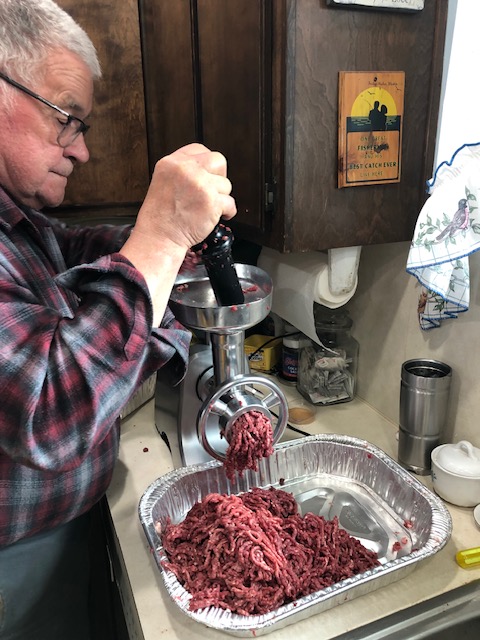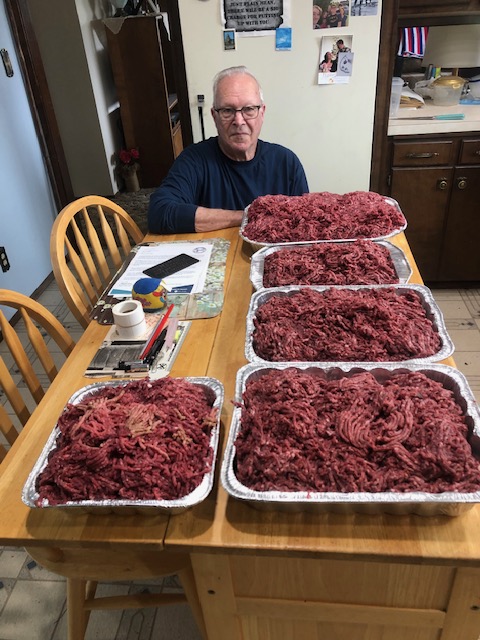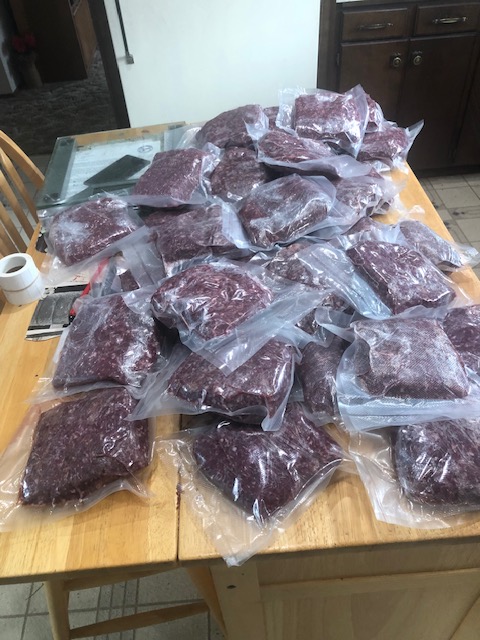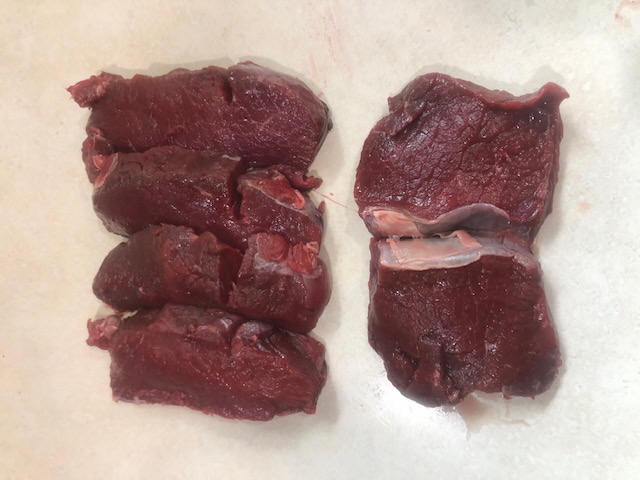
Venison
 |
Processing Your Own Venison
|
Here, I will not discuss the
initial butchering, as there is probably many different ways, along with YouTube
as a help. I will cover how I have done my processing for at least 70
years of farming/hunting, this being refined, as it has filtered out many not so beneficial
blunders.
Road Kill ; In this article I will be discussing processing a deer.
Kind of different in that I did not take it during a hunting season, but in the
end of March as a "Road Kill". In the state of Washington, it is
possible to salvage road kill. There are a few restrictions
depending on the region and specie, along with, you cannot shoot a wounded
animal to get it out of it's misery, probably because of how to prove whether it
was shot before or after it's close association with a moving vehicle.
You then have to go online within 24 hours and fill out a roadkill salvage
permit, which is processed and sent to you electronically within an hour to your e-mail.
In this case, one night, just before dark, I had a knock on
my door, from a considerably past middle aged gentleman who wanted to know if I
had a gun. To partly explain, I have operated a gunshop out of my detached
garage for 30 years and have been retired for another 20, so many still know of
me, so the suspicion would be great that I would have access to a firearm. He
explained that he had just hit a deer on the highway, possibly 500 yards from my house, and that
it was still alive, which he wanted me to dispatch it. I explained that it
I shot it, that would be in the eyes of the law, as me poaching it. Where in this
instance, only
law-enforcement had that privilege. His comment was "I can't see well and
my hearing is also bad".
I asked if it damaged his vehicle, his response was not that
he could tell. However the vehicle was a newer Jeep Wrangler with a
extended front pipe pumper guard.
He was very adamant that he did not want to have this deer suffer.
Okay, I grabbed a pistol and lets go take a look. By the time
we got back to the location where the deer was laying in the ditch, it looked
very much like it had then
became deceased. He drove me back to my place, dropped me off and drove
off. It appeared to me that they were probably on the way to a meeting of some kind
and did not want to be late. I had never seen him before that I was aware
of, but his female companion, (very possibly his wife) looked very close like
being an aunt (who lived 40 miles west of me) of one of my neighbors.
Now with him making haste
in the other direction, I was the only one
knowing what/where this dead deer was.
I was aware of these salvage
permits as a few years before, as I had a small deer hit on the highway in front of my
house that wound up in the ditch at my front yard (of which I had witnessed the
situation) and I did salvage it.
This deer was a good sized doe, and I am to old to handle a
deer of that size by myself, especially along a busy highway, so I called my
neighbor. OK, lets go get it.
It took both of us to roll this deer into the bed of his Ford
Ranger pickup. She was a good sized barren doe, OR if she was pregnant,
the fawn would be a real late one. By the time we got her hung in my barn
and all butchered out it was 9PM. This was not what how I had
planned my evening.
We never knew what killed her, but there was two ribs near
the shoulder that were really busted up, and a large burse on the hip area also,
however we never really looked the head over for any signs of damage.
In my mind she jumped out right in front of this vehicle and the bumper guard
had done it's job well.
This particular area is well known as a deer crossing from one 20+
acre patch of nice timber, into a smaller strip of smaller timber which is
between a farmer's field and a couple of houses. In the 50 years that I
have lived here, NUMEROUS road-kill has occured.
I am 88 years old, have COPD along with Spinal Stenosis so
for me to take care of this animal, it would have to be in stages, and my
neighbor was committed for doctors appointments for his wife the next day.
We were going to make 98% of this meat into hamburger, so there was
no need to cut the carcass down the middle and the weather was rather cool, I
had it all boned out in two days. So I
just started by cutting the shoulders off. Since this was going to be
mostly hamburger, I simply boned out everything, leaving the ribcage still
attached and hanging. During this boneing, I was disposing of whatever bloodshot
membrane or meat was visible. For the rest, would go to my barn, get what I could carry into
the house, lay it on a large wooden cutting board and proceed to bone it out.
This took a little over one day.
When done, I had two large metal pails (like those used for
water-bath canning) full of meat. After boneing then next was to cut all this meat into
strips about 1" in size and 5-6" long. This was so they would feed
easily in the meat grinder. This again also allowed me to separate out any
other bruised or bloodshot meat.
Then we both had commitments for the next couple of days so I
stored this meat in a spare refrigerator.
When done, we had slightly more than 60 pounds of meat. Since
venison is very lean, we added 10% pork trimmings. I don't like a lot of
pork fat, as when cooking the meat shrinks a lot, so my 10% is close, however on
this, maybe another 5% would have been OK.
The meat grinder we will be using is a
Cabelas one that I purchased using my points gained off my Cabelas credit card.
In grinding, we used those thin disposable large aluminum turkey baking pans,
which were low enough to fit under the grinder's outlet and yet allow a lot of
meat to be stacked up.
During this grinding, I mixed in the pork trimmings in with the
venison, to make it (the final product) more blended.
This meat was ground twice, first with a course grinder insert, then secondly with a smaller one. On the second grind, the meat did not want to fall down easily into the grinder entrance, so below you can see the use of a tamper. One trick at the end of the grinding, you will have a lot of unprocessed meat stuck inside, the simple thing to do when all the grinding is done, is to feed in a slice of bread, which forces the meat out and what bread comes out is also edible in the end.
|
Here on the left is a pan of the first grind & ready to start the 2nd grind |
Here the tamping of the meat on the 2nd grind |
 |
 |
This process was time consuming, especially we both had to take a break oftener
than if we were younger.
We decided to make paddies about 1 1/2#, as that would be
enough for a couple meals, or enough for a meat loaf. These were made using
a meatloaf pan, filling it about 1/2 height and 2/3rds the length. The
meat was stuffed in the pan, then using Saran Wrap, on a large cutting board,
slam the pan of meat onto the Saran Wrap hard enough that the meat plops out.
The Saran Wrap was then wrapped around the meat, ready to be inserted into
freezer bags for vacuum packing.
As you can see below we had a lot of meat. And we even saved
out a few steaks.
| Here you see 60# of hamburger | Here the final vacuum packed product ready for freezing (38 bags) |
 |
 |
In the photo below are some of the steaks we saved, the partial sirloin on the left, with butterfly tenderloin on the right.
| Here the few steaks we saved out |
 |
Normal Variety of Meat ; In the photo below is what you could expect to see of meat cut from a young whitetail buck. Here hamburger, stew meat, sirloin steaks, roasts, back-strap steak and tenderloins.

Back to the Main Ramblings Page
Copyright © 2025 LeeRoy Wisner All Rights Reserved
Originated 04-01-2025, Last updated
04-08-2025
to contact the author click here